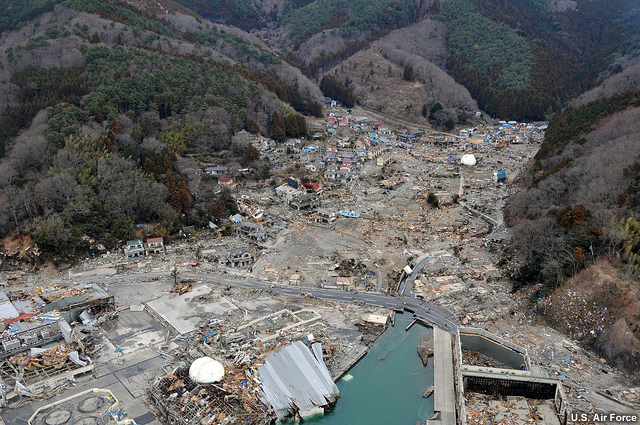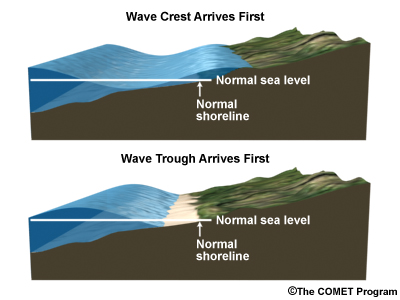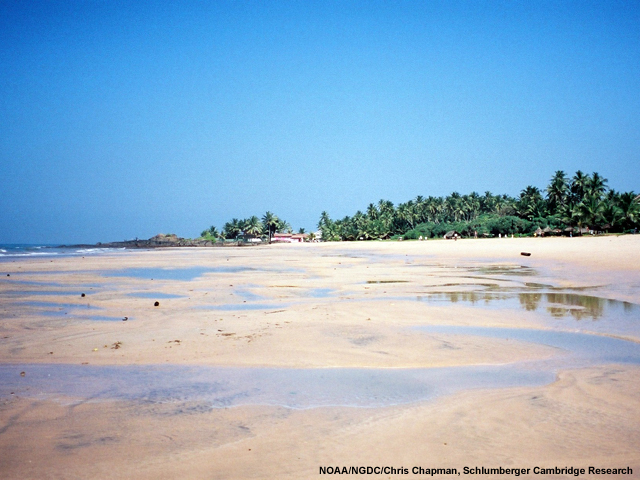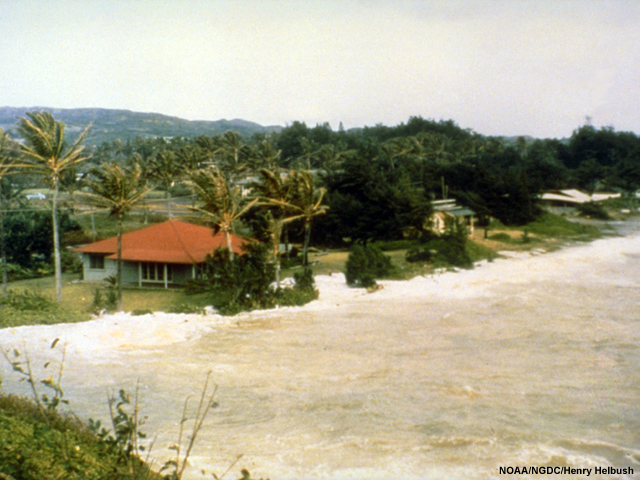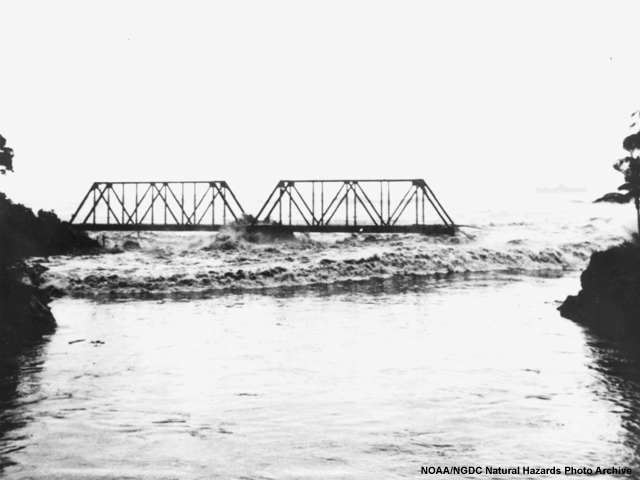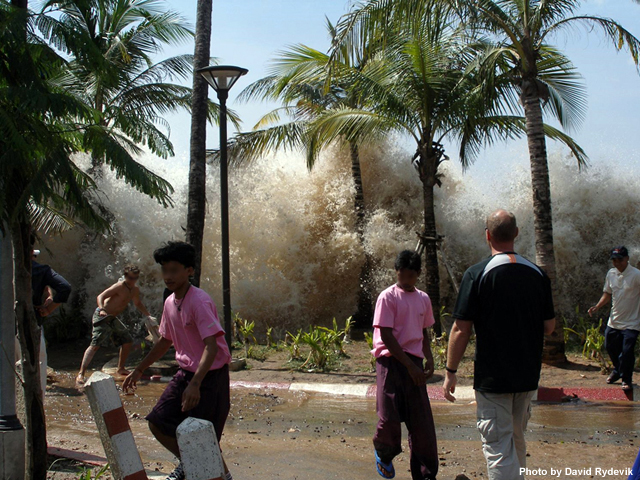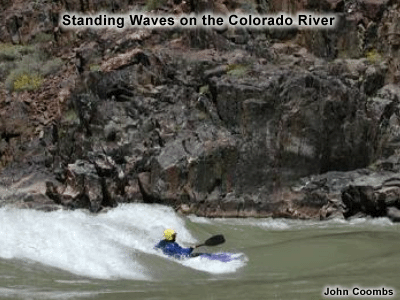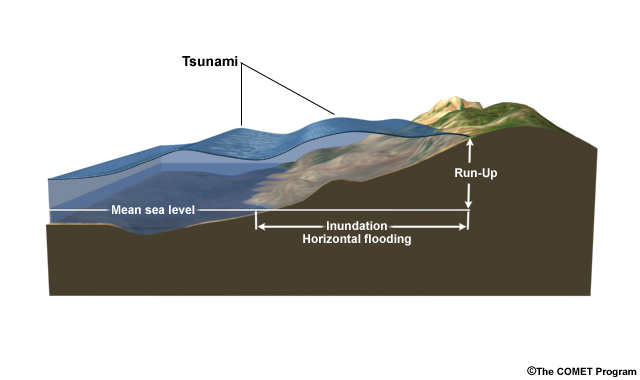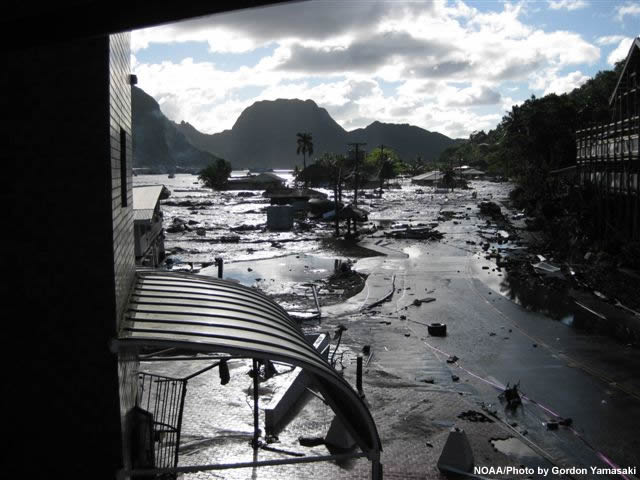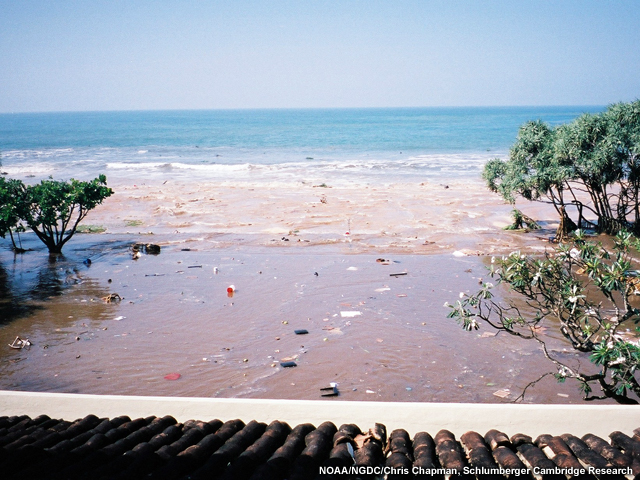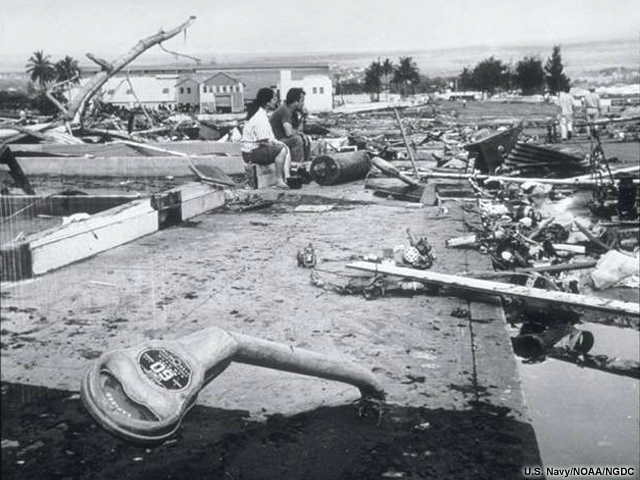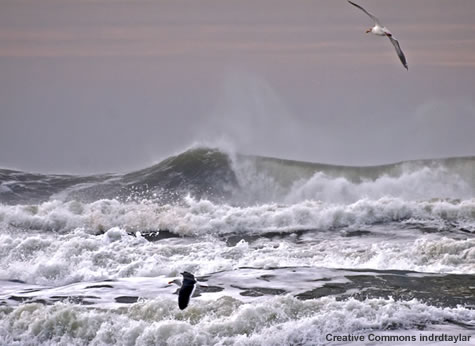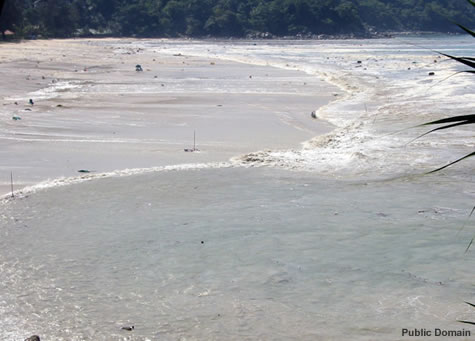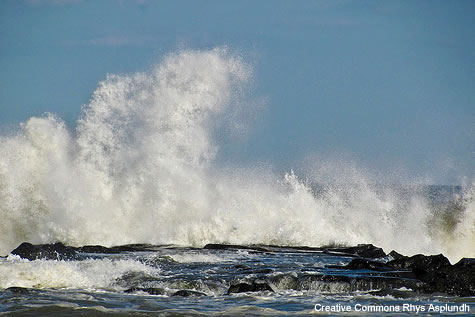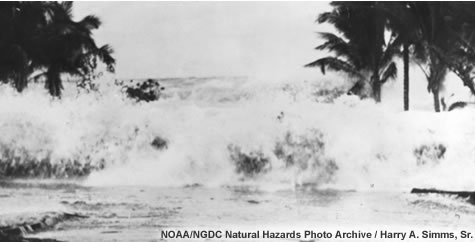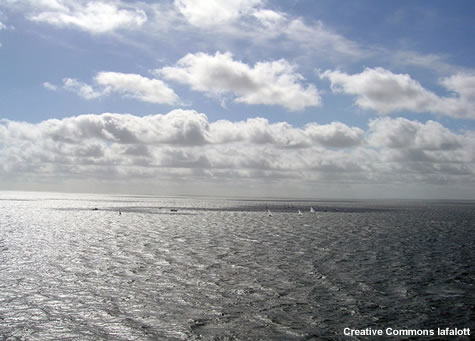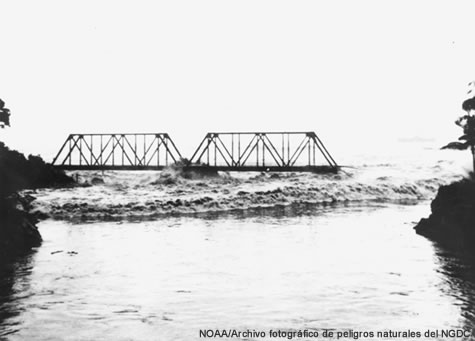Recognizing a Tsunami
Tsunami is Japanese for "harbor wave" and describes the series of waves commonly caused by an
earthquake or seismic event.
What does a tsunami look like when it arrives at the coast? Look at these pictures and decide
which are photos of tsunamis and which are photos of other types of waves.
Question 1
Is this a tsunami? (Choose the best answer.)
The correct answer is b).
No. This is a large breaking wave that's a part
of regular ocean swell. Although tsunamis sometimes create large
breaking waves, more often they appear in other forms.
Please make a selection.
Question 2
Is this a tsunami? (Choose the best answer.)
The correct answer is a).
Yes. This is an unusual sudden retreat of water
from the shore that can accompany tsunamis.
Please make a selection.
Question 3
Is this a tsunami? (Choose the best answer.)
The correct answer is a).
Yes. This is a strong current pushing a river
upstream caused by a tsunami.
Please make a selection.
Question 4
Is this a tsunami? (Choose the best answer.)
The correct answer is b).
No. This is a regular ocean wave crashing on the
rocks. The waves around it show no sign of a tsunami.
Please make a selection.
Question 5
Is this a tsunami? (Choose the best answer.)
The correct answer is a).
Yes. These surging waves are common in tsunamis.
Please make a selection.
Question 6
Is this a tsunami? (Choose the best answer.)
The correct answer is b).
No. This is high ocean swell at sea, but not a
sign of a tsunami.
Please make a selection.
Question 7
Is this a tsunami? (Choose the best answer.)
The correct answer is b).
No. These are regular short-wavelength ocean
waves. However, a tsunami might look like this at sea, with short
wavelength waves rippling on top of it.
Please make a selection.
Question 8
Is this a tsunami? (Choose the best answer.)
The correct answer is a).
Yes. This effect, in which water rises very
rapidly, often occurs in a tsunami.
Please make a selection.
Question 9
Is this a tsunami? (Choose the best answer.)
The correct answer is a).
Yes. This wave produced by water surging up a
river against a current is called a bore, and tsunamis can produce
them.
Please make a selection.
Arrival at Shore
As you could see in the previous exercise, tsunamis don't all look the same when they arrive
at shore. Why? It has to do with the shape of tsunami waves. Every wave has a crest and a
trough. When the trough comes first, the sea level gets lower, so it withdraws from the
shore.
Suddenly beach is visible where there was water before. Stranded fish flop around and can
lure reckless beachgoers closer to danger.
When the crest comes first, the water can appear like a swiftly rising tide or like a single
or series of surges of water. In either case, the volume of water that follows can far
exceed anything produced by tides—remember that because of a tsunami's long wavelength, the
wave can be hundreds of kilometers from crest to crest.
Only occasionally does a tsunami arrive like a massive wall of curling water—the way
most people think of tsunamis.
A tsunami is usually not just one wave. Tsunamis arrive as a series of waves at unpredictable
intervals, making the coastline dangerous for many hours. And—importantly—the
first wave is not necessarily the biggest.
Tsunamis sometimes have other odd appearances. They can produce standing waves, a phenomenon
often seen in rivers, where the crest actually remains in one place while the water runs
through it.
Whirlpools may also suddenly appear when the front of the tsunami turns and retreats while
the rest is still coming in.
Do an Internet search for "japan tsunami whirlpool" to view the amazing whirlpool
from the March 2011 tsunami.
Inundation and Runup
Inundation refers to the horizontal distance inland that a tsunami reaches. Inundation is
usually measured perpendicular to the shoreline and provides an estimate of how far the
flooding extended. In the 2011 tsunami in Japan, the inundation measured almost 10
kilometers (6 miles) inland in some areas.
While inundation represents the tsunami's horizontal reach, a tsunami's vertical reach is
called runup. Runup is the difference between how high the tsunami reaches on land and the
sea level prior to the wave's arrival. Tsunami waves increase in height as they approach
shore.
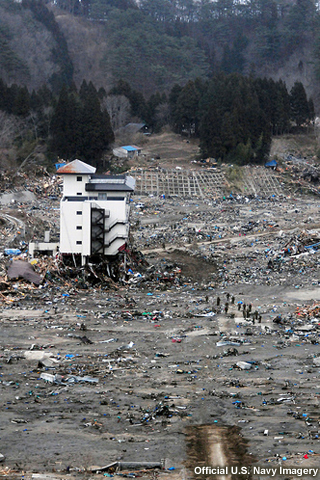
Tsunami damage in Japan following March 2011 earthquake and tsunami. The bottom floors of multistory building have been washed away by waves.
Once the waves meet the shoreline, runups can be very large. For instance, a wave that is 2 m
(6.5 ft) high off shore may reach two to five times that height on shore.
Successive waves can push the water even higher and farther.
Topography refers to the shape and features of the land. Once waves wash up onto shore,
topography helps determine where inundation and runup will be largest. Features such as
funnel-shaped bays or steep walled valleys can heighten waves and increase runup.
Retreat
When the wave exhausts its momentum and turns back to sea, it's still capable of destruction.
It's now armed and dangerous—a swirling mass of boards, tree limbs, furniture, and
cars.
And It may be moving faster on its way back out to sea, especially if it is retreating
downhill.
Nature's Warning Signs
Tsunamis can come ashore quickly, so it's important to know the signs and be prepared so that
you react immediately. Test your knowledge by correctly identifying the Tsunami Signs listed
here.
I know a tsunami might be occuring if...
Question 1
I see rapid or unusual water movements.
The correct answer is a).
True: Fast, frothy currents or other unusual
water movements can be signs of an incoming tsunami. Get away from
the water.
Please make a selection.
Question 2
Animals are acting strangely or making a mass exodus.
The correct answer is b).
False: Although there is anecdotal evidence about
animals sensing earthquakes and moving to higher ground, relying on
a herd of stampeding animals to warn you of a tsunami is likely not
the best bet for saving your life.
Please make a selection.
Question 3
A strong earthquake made it difficult to stay on my feet.
The correct answer is a).
True: If you are near the coast and feel strong
shaking, particularly if the shaking knocks you down or lasts more
than 20 seconds, get yourself away from low-lying areas near the
water. A local tsunami could hit within just minutes.
Please make a selection.
Question 4
There is a torrential rain storm and the waves at the beach look huge.
The correct answer is b).
False: Rain and wind storms do not cause
tsunamis. Tsunamis are generated by earthquakes or other seismic
events.
Please make a selection.
Question 5
The newspaper has information and instructions.
The correct answer is b).
False: TV, radio, and the Internet will have
information about an approaching tsunami if there is time before it
arrives, but your daily newspaper would have been printed before the
threat emerged.
Please make a selection.
Question 6
It has been raining for many days and puddles are getting deep.
The correct answer is b).
False: Rain storms don't cause tsunamis, unless
extremely heavy rains have loosened hillsides, which can cause a
landslide into the ocean.
Please make a selection.
Question 7
The water level dropped drastically.
The correct answer is a).
True: If the water is lower than you've seen,
it's not a good sign. Move to high ground immediately.
Please make a selection.
Question 8
The sea level appears to be rising rapidly.
The correct answer is a).
True: Rapid rises in sea level should signal you
to get to higher ground as quickly as you can.
Please make a selection.
Question 9
The sky is overcast and there is lightning.
The correct answer is b).
False: Lightning storms do not cause tsunamis.
Please make a selection.
Question 10
There are TV and radio reports about a tsunami moving across the ocean.
The correct answer is a).
True: If the tsunami is from a distant source,
there will be advance warning and information about its approach on
TV, radio, and the Internet too.
Please make a selection.
Question 11
The tide is lower than I've ever seen it.
The correct answer is a).
True: If the tide looks unusually low, do not go
out to explore the beach. The front edge of a tsunami is sometimes,
but not always, a receding wave. This drawback happens much more
quickly and can be more dramatic than a low tide. When the water
comes back, it will be the crest of a tsunami wave, and you
shouldn’t wait around to see it. Instead, move quickly to a safe
place on higher ground.
Please make a selection.
Question 12
The weather has changed drastically with heavy rain followed by a dry
spell.
The correct answer is b).
False: Weather changes, including wet or dry
spells, do not contribute to tsunamis.
Please make a selection.
Question 13
The wind is blowing extremely hard.
The correct answer is b).
False: Though fierce winds can sometimes blow
waves very high, they are not a sign that a tsunami is on the way.
In some situations, constant winds of the right speed can generate
something called a “meteotsunami,” but these are not as large as
tsunamis caused by earthquakes, landslides, volcanoes, or rare but
frightening meteor impacts.
Please make a selection.
Question 14
Emergency officials asked me to evacuate the beach and stay away from
harbors.
The correct answer is a).
True: If the tsunami is from a distant source,
there will be advance warning. Heed the instructions of local
authorities and stay out of hazard areas.
Please make a selection.
Question 15
I hear people screaming at the beach.
The correct answer is b).
False: People could be screaming for a reason
other than a tsunami. If there is a tsunami, do not panic or scream.
Instead, calmly alert other beachgoers so you can all move quickly
and quietly to higher ground.
Please make a selection.
Summary
A tsunami is a series of waves typically caused by an
earthquake or other seismic event below or near the ocean floor.
Incoming tsunamis can have different appearances, but typically they do not look
like a towering, curling wall of water.
A tsunami might arrive crest-first as a swiftly rising tide or surge of water,
or trough-first, in which the water recedes first, then quickly and suddenly
rushes shoreward.
Tsunami waves arrive in unpredictable intervals–and the
first wave is not necessarily the biggest.
Tsunamis can travel far inland. This horizontal reach of a tsunami called
inundation. The vertical reach of a tsunami is called runup .
Topography refers to the features and shape of the land. These features can
funnel the water through valleys, bays, and up rivers, causing extremely high waves.
Retreating waves are at least as dangerous as incoming waves due to their fast
movement and accompanying debris.
Click here to return to the 30 Minutes
Page.
